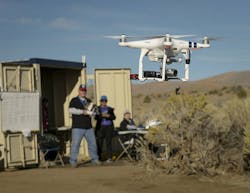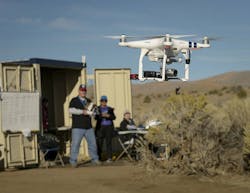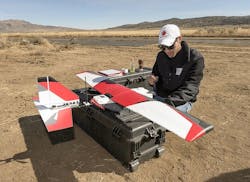NASA conducts first beyond-line-of-sight flight test, advancing unmanned air traffic management
RENO, Nevada, 20 Oct. 2016. A team of engineers from NASA’s Ames Research Center in Moffett Field, California, flew four unmanned aircraft systems (UAS), also commonly called drones, beyond the operator’s visual line of sight during a flight test at Reno-Stead Airport in Reno, Nevada. The tests were part of NASA’s UAS traffic management (UTM) research platform, with the goal of safely integrating unmanned aircraft into the national airspace system (NAS), led by Parimal Kopardekar, manager of NASA’s Safe Autonomous Systems Operations project.
The “out of sight” tests, led by NASA in coordination with the Federal Aviation Administration (FAA) and several partners, were the latest waypoint in solving the challenge of drones flying beyond the line of sight (BLOS) of human operators without endangering other aircraft, officials describe.
Drone Co-habitation Services operates a Phantom 3 commercial multi-rotor unmanned aircraft, one of 11 vehicles in the UTM TCL2 demonstration that will fly beyond line of sight of the pilot in command in Nevada test. (Credits: NASA Ames / Dominic Hart)
During the BLOS flight test, two drones flew beyond their commanders’ lines of sight. As many as two drones were operated in the same test airspace, separated by altitude and within sight of their operators. The pilots used the NASA-developed UTM research platform to gain information about all the drones’ locations and proximity to other air traffic and hazards. UTM also informed other airspace users of potential hazards and conflicting operations that could affect their plans.
Before multiple drones can fly in the same area, beyond the pilots’ view, procedures need to be in place to safely manage the traffic. Operators must be aware of other aircraft around them, no-fly zones (also known as geo-fenced areas), and man-made and natural hazards, such as severe weather or unanticipated events in the area.
During testing, NASA engineers demonstrated UTM’s Technical Capability Level 2 (TCL2) by connecting real drone-tracking systems to the research platform, providing alerts for approaching drones and piloted aircraft (live or simulated), as well as providing information about weather and other hazards. UTM partners used various unmanned aircraft connected to the research platform to test UAS operations, enabling engineers from NASA and the FAA to refine and develop the research.
“The NASA UTM program is groundbreaking and we are excited to be part of the effort,” says Mark Barker, director of business development at Nevada Institute of Autonomous Systems (NIAS), which is responsible for the FAA-designated Nevada UAS Test Site. “NASA, NIAS, and all the Nevada Teammates are truly advancing the unmanned systems industry.”
When three UAS flew close together, they were within view of their operators. Current FAA regulations require that drone operators are able to see any other aircraft in order to avoid them, which limits many potential applications for drone technology. The UTM demonstration will help regulators and researchers assess the capabilities and procedures that could support operations beyond operators’ visual lines of sight.
The operators used common data exchange protocols -- developed jointly by NASA, the FAA, and industry -- to flag their intended use of the airspace stay aware of any real-time constraints.
Precision Hawk pilot readies aircraft for test flight. (Credits: NASA Ames / Dominic Hart)
This test logged several firsts:
First UTM demonstration of multiple drones flying beyond visual line of sight of the pilot, with paths separated by altitude. This used the UTM research platform for information about potential hazards and conflicting operations.
First demonstration of prioritizing airspace access for emergency response drones through UTM airspace management combined with notification of other UAS operators to clear the area.
First demonstration of system detect-and-alert capabilities. Live radar and weather systems provided alerts to UTM operators based on real data measurements. The team also introduced simulated weather events, such as high winds, to obtain operator feedback and further refine the capability.
Enhanced demonstration of automated alert when aircraft are not conforming to their flight plans. This safety feature warns UAS operators and, in future, FAA systems of these hazards, such as a drone flying away from its planned path or loss of connection with an operator.
First demonstration of dynamic re-routing capability that allows an unmanned, airborne vehicle to request flight plan changes. This function allows operators to update their missions in response to either changing airspace conditions or new mission objectives.
With the most recent tests complete, NASA now will offer the capabilities to all FAA test sites for further validation and assessment.
UTM’s Technical Capability Level Three testing is planned for January 2018 and will involve evaluating tracking procedures for managing cooperative and uncooperative drones to ensure collective safety of manned and unmanned operations over moderately populated areas.
This animation simulates testing performed Wednesday, Oct. 19, 2016, by a team from NASA’s Ames Research Center at Reno-Stead Airport in Reno, Nevada.
Technical Capability Level Four, planned for 2019, will involve higher-density urban areas for autonomous vehicles used for newsgathering and package delivery, and will offer large-scale contingency mitigation.
Collaborators for the October flight test includes: Aerovironment Inc.; Monrovia, California; Alaska Center of UAS Integration, Fairbanks, Alaska; Drone Co-Habitation Services, Wilmington, Delaware; Gryphon Sensors, Syracuse, New York; Lone Star UAS Center, Corpus Christi, Texas; Modern Technology Solutions Inc., Alexandria, Virginia; Nevada Institute of Autonomous Systems, Reno, Nevada; Precision Hawk, Raleigh, North Carolina; Proxy Technologies, Reston, Virginia; Silent Falcon, Albuquerque, New Mexico; SmartC2, Grand Forks, North Dakota; University of Nevada-Reno, Reno, Nevada; and Unmanned Experts, Denver, Colorado.
Search the Aerospace & Defense Buyer's Guide
You might also like:
Subscribe today to receive all the latest aerospace technology and engineering news, delivered directly to your e-mail inbox twice a week (Tuesdays and Thursdays). Sign upfor your free subscription to the Intelligent Inbox e-newsletter at http://www.intelligent-aerospace.com/subscribe.html.
Connect with Intelligent Aerospace on social media: Twitter (@IntelligentAero), LinkedIn,Google+, and Instagram.
Intelligent Aerospace
Global Aerospace Technology NetworkIntelligent Aerospace, the global aerospace technology network, reports on the latest tools, technologies, and trends of vital importance to aerospace professionals involved in air traffic control, airport operations, satellites and space, and commercial and military avionics on fixed-wing, rotor-wing, and unmanned aircraft throughout the world.



